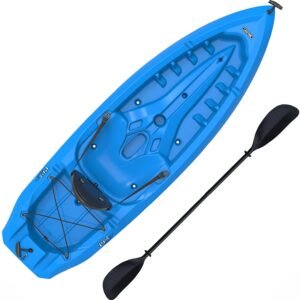When kayaking, you just have to wear a PFD. The same goes for everyone who is with you.
There are many life jackets available out there, so choosing the right one is somewhat of a challenge. And you really need to approach PFD selection seriously since it will impact your comfort and safety when paddling.
Don’t know what to do?
If so, then we’ll be giving you all the info you need to choose the right PFD!
Do you need a life jacket for kayaking?
Well, the answer is simple: you do indeed need a life jacket for kayaking. And not only for kayaking but also for any type of boating activity.
As we’ve said in our material on kayaking safety tips, a considerable share of drowning victims in the latest years haven’t been wearing a life jacket.
It is pretty safe to say that the victims would most likely not drown if they had a PFD on.
You now see why you should be wearing a PFD at all times, right?
PFD types
The United States Coast Guard categorizes personal flotation devices into 5 types:
Type I/off-shore life jackets
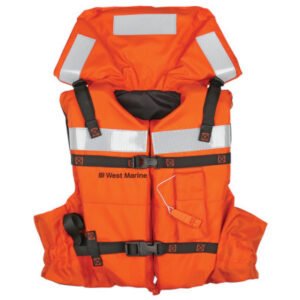
Type I PFDs are engineered for use in rough water or remote areas where rescue may be slow.
These bulky PFDs have the most buoyancy and are able to turn unconscious people into a face-up position in most cases.
Type II/near-shore buoyant vests

Type II PFDs are designed for calm water and situations where rescue is likely to be fast. These are good for general boating activities.
These are less buoyant than Type I PFDs, but they are able to turn some unconscious people into a face-up position.
Type III/flotation aids
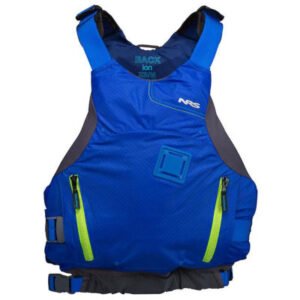
These PFDs offer a quite good freedom of movement and comfort during continuous wear.
Type III PFDs are designed for general boating or the specialized activity marked on the PFD (e.g. hunting, kayaking, fishing, etc.).
These PFDs aren’t designed to turn unconscious people into a face-up position. Rather, they are built to allow wearers to put themselves face-up.
Type IV
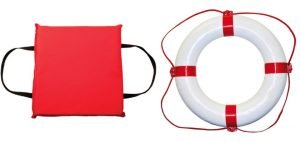
Type IV PFDs are meant to be thrown to a conscious person in the water. They aren’t designed to be worn and instead serve as a backup to a wearable PFD.
Examples of Type IV PFDs are life rings and buoyant cushions.
Type V/special use devices
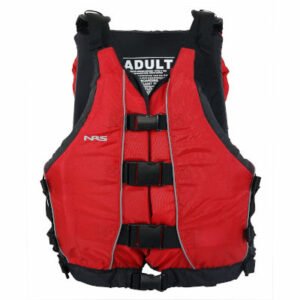
A Type V PFD is only intended for a specific activity like windsurfing or kayaking.
Type V PFDs must be worn at all times during the activity specified on its label.
Kayakers most commonly choose Type III and Type V life jackets because they provide adequate comfort and more than enough buoyancy. You should probably also look no further than those two types.
Inflatable vs standard PFDs
PFDs can be standard (also called inherently buoyant) or inflatable.
Standard PFDs

A standard PFD is a non-inflatable kind of a life jacket. It looks like a vest and uses a flotation material – mostly foam – to create buoyancy.
Typically, kayakers use Type III standard PFDs.
Pros of standard PFDs
- A standard PFD is low-maintenance: other than cleaning and drying it out after use, there is nothing else you need to do to maintain them.
- Unlike inflatable PFDs, standard PFDs don’t require any preparatory procedures before use. You just put it on ready-to-use.
- Another small upside of standard PFDs is that they can have pockets to keep your snacks, gear, and whatnot in.
Cons of standard PFDs
- Standard PFDs tend to be quite bulky and restrictive on the movements.
Inflatable PFDs
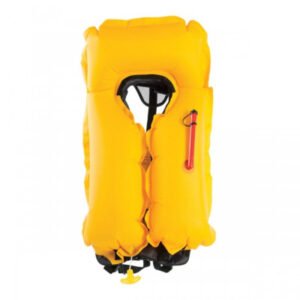
Inflatable PFDs, as their name suggests, need to be inflated before becoming buoyant.
Any inflatable PFD contains an inflator mechanism and a carbon dioxide cylinder. When the carbon dioxide cylinder is triggered, the bladder gets filled with air.
Because the cylinder gets punctured to start the inflation, it needs to be replaced after you have an accident while kayaking.
When deflated, an inflatable PFD is very compact, which makes its storage and transport much easier. Besides, because they cover less upper body area, they are generally more comfortable to wear.
There are two types of inflatable PFDs – automatic and manual.
Automatic inflatable PFD
In an automatic inflatable PFD, the carbon dioxide cylinder is triggered only upon submersion to a certain depth. That depth is determined by the manufacturer of the vest.
Pros of auto inflatable PFDs
- Auto inflation.
- The PFD will get inflated even if the wearer is knocked unconscious or is incapacitated by the cold water.
Cons of auto inflatable PFDs
- An auto inflatable PFD may inflate from minor contacts with water, e.g. during rain.
Manual inflatable PFD
In a manual inflatable PFD, the carbon dioxide cylinder is triggered when you pull the knob that is usually located at the waist of the PFD.
Pros of manual inflatable PFDs
- You decide when to inflate the PFD.
- No chance of accidental inflation.
Cons of manual inflatable PFDs
- Useless if you get incapacitated in an accident.
Hybrid PFDs
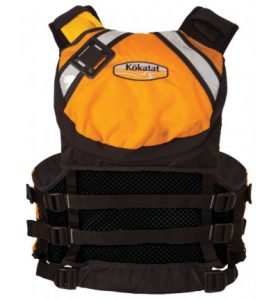
There also are hybrid PFDs that combine the benefits of standard and inflatable PFDs like comfort and inherent buoyancy.
You’ll probably see just a few hybrid PFDs when looking for a life jacket: there aren’t that many models available out there.
Besides, hybrid PFDs tend to cost much more than standard or inflatable PFDs.
Which one to choose?
In most cases, you would want to go for a standard non-inflatable PFD since it is the more reliable option.
On the other hand, if you find that standard PFDs restrict your movements too much, then you would want to go for an inflatable PFD. Just make sure that you realize all the risks of choosing an inflatable life jacket.
Comfort of wearing and fit
The comfort and fit are the most important things to look for in a life jacket.
If a PFD isn’t comfortable for you and doesn’t fit you well, then it will, on one hand, limit your movements and compromise your safety on the other.
Women’s & men’s PFDs
Some women may find men’s or unisex PFDs uncomfortable to wear due to their body curves, bust lines, or the shorter torso. Fortunately, there are women’s PFDs available out there for them.
Some women may be able to wear unisex PFDs though. In fact, they may find women’s PFDs too loose on them.
Keep this in mind when choosing a PFD.
PFD sizing
PFDs come in different sizes as well.
Adult PFDs are sized by the chest size (30 – 52 inches), while kids’ PFDs are sized by body weight (8 – 90 pounds). The chest size is measured at its broadest point.
PFD manufacturers usually provide sizing guides on their products, so you should be able to easily find the right PFD for you.
Checking the fit of the PFD
A PFD needs to fit snugly and securely so it doesn’t just slide up and come off of you, but not so snugly to hamper your movements.
To check whether or not the PFD is a good suit for you, do the following:
- Put on the clothes you’ll be wearing when kayaking.
- Following the instructions of the PFD, put it on. All its straps need to be loosened.
- Tighten the PFD’s straps until it feels snug, starting from the waist and ending with the shoulders.
- Have someone pull the PFD up on you. If the PFD moves past your nose or head, tighten the straps and retest. If the PFD still moves up, then it is too large for you.
- After you’ve found a snug fit, move around to make sure that the PFD doesn’t limit your movements.
Check if it is comfortable in a seated position, grab a paddle and do strokes, and try to simulate what you will be doing when kayaking. If you find that the PFD allows you to move freely, then it is the right one.
This process is the same for both adult and kids’ PFDs.
Buoyancy
The buoyancy of a life jacket will determine how well it will be able to keep your head and chin above the water surface. Buoyancy is measured in pounds or Newtons.
Most adults need about 7-12 pounds of buoyancy to stay afloat, and since any quality PFD will provide more than that, you shouldn’t pay too much attention to the buoyancy in most cases.
How much buoyancy do you need?
There are several factors that determine how much buoyancy you would need to stay afloat:
- Body weight.
- Body fat.
- Lung size.
- Water conditions (rough or calm).
The USCG provides the minimum required buoyancy for different PFD types:
[wpsm_comparison_table id=”4″ class=””]
Testing the buoyancy of the PFD
The best way of finding whether or not the PFD is buoyant enough for you is testing it in water.
So assuming that you’ve picked a life jacket that fits you snugly and comfortably, the next thing to do would be to try the PFD in shallow water or a swimming pool in your backyard.
To check your PFD, do the following:
- Put the PFD on. Make sure to adjust it snugly.
- While in the water, relax your body and tilt your head back.
- Your chin and mouth need to be above the water surface so you breathe easily. If you can’t breathe freely in a PFD, then you need more buoyancy.
- Keep in mind that the clothes you wear, items in your pockets may change how well the PFD will work.
When testing the PFD, you should wear the same clothes and have the same items on you as you would when kayaking.
Additional features
After you are done with comfort, you may look for some other issues that could make your life easier when kayaking.
Color
Going for a bright-colored PFD is a very good idea because you will be more visible in it.
Reflective tape
A reflective tape cover also makes you more visible, but it is designed to do so in low-light conditions.
Breathability
If you’ll be kayaking in hot weather conditions, then you may want to look for a life jacket that has got vents in it.
Pockets & tool hangers
Pockets would allow you to have your essentials like a smartphone or a pocket knife close by.
If you’ll be fishing from a kayak, tool hangers would come in handy for you to keep your lures and hooks on hand.
Grabbing handle
A grabbing handle is most commonly found in infants’ and small children’s PFDs. It assists retrieving the child out of the water. This definitely is a feature that should be in a child’s PFD.
Crotch strap
A crotch strap is also seen in infants’ and small children’s PFDs. It provides additional assistance in keeping the PFD in its place on the kid, so it is another feature to look for.
Final thoughts
Hopefully, you were able to find the right info to choose the right PFD with.
If that’s the case, then just go and look for the best life jacket. Don’t forget to test it!
If there is something missing, do more research, or feel free to drop in a question in the comments below!
